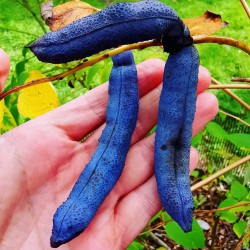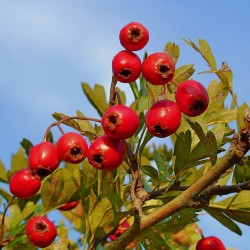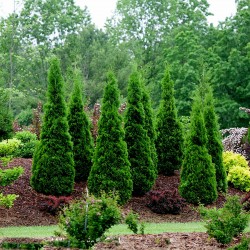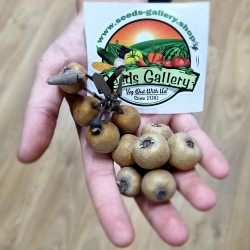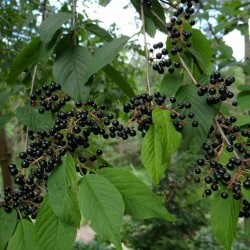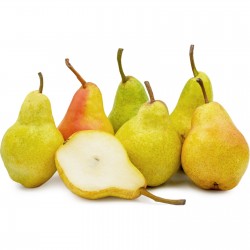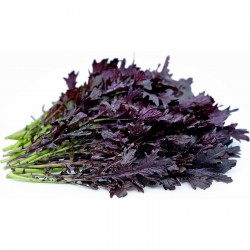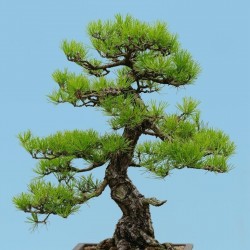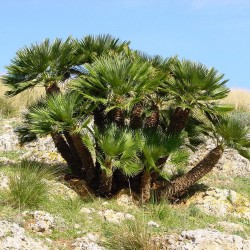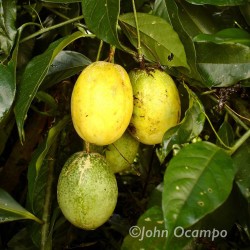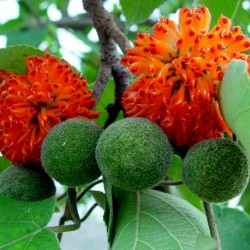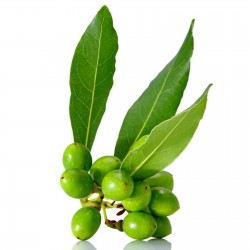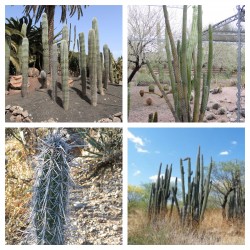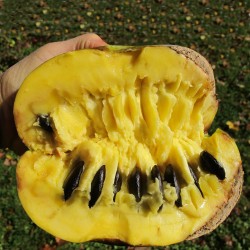Seeds Gallery EU,
5/
5
<h2><strong>Насіння пау-пау, гірськи́й бана́н (Asimina triloba)</strong></h2>
<h2><span style="color: #fe0000;"><strong>Ціна за упаковку з 3 насінин. </strong></span></h2>
<strong style="color: #202122; font-family: sans-serif; font-size: 14px; background-color: #ffffff;">Азимі́на трилопате́ва</strong><span style="color: #202122; font-family: sans-serif; font-size: 14px; background-color: #ffffff; float: none; display: inline;"> (</span>лат.<span style="color: #202122; font-family: sans-serif; font-size: 14px; background-color: #ffffff; float: none; display: inline;"> </span><em style="color: #202122; font-family: sans-serif; font-size: 14px; background-color: #ffffff;">Asimina triloba</em><span style="color: #202122; font-family: sans-serif; font-size: 14px; background-color: #ffffff; float: none; display: inline;">), також відома під назвами </span><strong style="color: #202122; font-family: sans-serif; font-size: 14px; background-color: #ffffff;">пау-пау</strong><span style="color: #202122; font-family: sans-serif; font-size: 14px; background-color: #ffffff; float: none; display: inline;"> або </span><strong style="color: #202122; font-family: sans-serif; font-size: 14px; background-color: #ffffff;">гірськи́й бана́н</strong><span style="color: #202122; font-family: sans-serif; font-size: 14px; background-color: #ffffff; float: none; display: inline;"> — вид дводольних квіткових рослин із роду </span>азиміна<span style="color: #202122; font-family: sans-serif; font-size: 14px; background-color: #ffffff; float: none; display: inline;"> родини </span>аннонових<span style="color: #202122; font-family: sans-serif; font-size: 14px; background-color: #ffffff; float: none; display: inline;">. Єдиний вид цієї родини, який може зростати та давати плоди за межами </span>тропічного клімату. <br /><br />
<h2><span id="Назва">Назва</span></h2>
<p>Наукова назва роду <em>Asimina triloba</em> взята з індіанської назви <em>assimin</em> через французьку <em>asiminier</em>, епітет <em>triloba</em> відноситься до квітів («трилопатеві» чашечки).</p>
<p>Вид має багато народних назв: «папая», «Paw Paw», «лапа-лапа», «динне дерево». Серед інших місцевих назв: «дикий банан», «банан прерії», «Indiana-банан», «Hoosier-банан», «західновіргінський банан», «канзаський банан», «кентуккійський банан», «мічиганський банан», «міссурійський банан», «банан бідняка», «Ozark-банан», «бананґо».</p>
<h2><span id=".D0.86.D1.81.D1.82.D0.BE.D1.80.D1.96.D1.8F"></span><span id="Історія">Історія</span></h2>
<p>Найперша документальна згадка про азиміну віднайдена за 1541 рік в доповіді іспанської експедиції Ернандо де Сото, яка знайшла її в індіанців Північної Америки, які вирощували її на схід від річки Міссісіпі.</p>
<p>Охолоджені фрукти азиміни були улюбленим десертом Джорджа Вашингтона і Томаса Джефферсона.</p>
<p>Експедиції Льюїса і Кларка іноді харчувалися азиміною під час своїх подорожей.</p>
<h2><span id=".D0.9E.D0.BF.D0.B8.D1.81"></span><span id="Опис">Опис</span></h2>
<p>Листопадне дерево або чагарник висотою до 15 м, зазвичай 4-5 м. Молоді пагони густо опушені; однорічні — голі, оливково-коричневі, блискучі; дворічні — сірі, з помітними сочевичками.</p>
<p>Бруньки коричнево-червоні, шерстисті. Листки обернено-довгасто-яйцеподібні, довжиною 12-30 см, шириною 4,5-12 см, на вершині коротко загострені, що поступово звужуються до черешка, цілокраї, шкірясті, з частими точковими залозками, видимими на просвіт, молоді листки знизу з червонувато-коричневим опушенням, пізніше цілком голі, світло-або сіро-зелені. Черешки довжиною 0,8-1,2 см. В середині осені вони жовтіють і опадають, нове листя з'являється в кінці квітня, коли рослина вже відцвітає.</p>
<p>Квітки зазвичай поодинокі, коричнево-пурпурові, діаметром до 4,5 см, з'являються в пазухах листків попередніх років, на кудлатій, опушеній квітконіжці завдовжки 1 — 3 см; три чашолистки яйцеподібні, гострі, зовні блідо-зелені і опушені; шість пелюсток широкояйцеподібні, тупо-загострені, темно-пурпурові або винно-червоні, з сітчастими жилками, рано відцвітають, зовнішні відігнуті, внутрішні прямостоячі. Кожна квітка містить кілька маточок, чим пояснюється здатність однієї квітки утворювати кілька плодів. Квітки двостатеві, але запилюються перехресно. У природних умовах азиміну трилопатеву запилюють падальні мухи і жуки-мертвоїди — її квіти видають несильний, але дуже неприємний запах, схожий на запах гнилого м'яса.</p>
<h3><span id=".D0.9F.D0.BB.D0.BE.D0.B4.D0.B8"></span><span id="Плоди">Плоди</span></h3>
<div>
<div><img alt="" src="https://upload.wikimedia.org/wikipedia/commons/thumb/1/17/Asimina_triloba_kz1.jpg/220px-Asimina_triloba_kz1.jpg" decoding="async" width="220" height="212" srcset="//upload.wikimedia.org/wikipedia/commons/thumb/1/17/Asimina_triloba_kz1.jpg/330px-Asimina_triloba_kz1.jpg 1.5x, //upload.wikimedia.org/wikipedia/commons/thumb/1/17/Asimina_triloba_kz1.jpg/440px-Asimina_triloba_kz1.jpg 2x" data-file-width="2568" data-file-height="2472" style="border-width: 1px; border-image-width: initial;" />
<div>
<div></div>
Квітка</div>
</div>
</div>
<div>
<div><img alt="" src="https://upload.wikimedia.org/wikipedia/commons/thumb/a/aa/Pawpaw-fruit.jpg/220px-Pawpaw-fruit.jpg" decoding="async" width="220" height="246" srcset="//upload.wikimedia.org/wikipedia/commons/thumb/a/aa/Pawpaw-fruit.jpg/330px-Pawpaw-fruit.jpg 1.5x, //upload.wikimedia.org/wikipedia/commons/a/aa/Pawpaw-fruit.jpg 2x" data-file-width="402" data-file-height="450" style="border-width: 1px; border-image-width: initial;" />
<div>
<div></div>
Плід</div>
</div>
</div>
<p>Плоди довжиною 5–16 см, шириною 3–7 см, важать від 20 до 500 г, по 2–8 плодів на одній плодоніжці, зазвичай довгасті, циліндричні або округлі, зазвичай дещо криві.</p>
<p>Насінини коричневі, довжиною 2–2,5 см, по 10–12 у кожному плоді, розташовані двома рядами (12-16% загальної ваги плоду). Насіння отруйне.</p>
<p>Шкірка у плодів тонка, напівпрозора, легко зчищається. Колір у міру дозрівання змінюється від зеленого до лимонно-жовтого, а після перших заморозків стає коричневим або чорним. М'якуш стиглого плоду м'який, білувато-жовтий або помаранчево-жовтий, з нудотно солодким смаком і приємним ананасово-суничним ароматом. Плоди багаті на фруктозу і сахарозу, а також на мікроелементи. Смаком зріла азиміна трохи нагадує банан або манго.</p>
<p>Цвітіння відбувається у квітні — травні, триває близько трьох тижнів. Плоди достигають протягом 4 тижнів у вересні-жовтні.</p>
<h2><span id="Поширення_і_екологія">Поширення і екологія</span></h2>
<p>У природі ареал виду охоплює Північну Америку — від південної частини Онтаріо (Канада) до Флориди. На заході його ареал доходить до південно-східної Небраски і Техасу<sup id="cite_ref-GRIN_2-0">[2]</sup>. Азиміна була завезена в Іспанію, Францію, Італію, Японію і ряд інших країн.</p>
<p><em>Asimina triloba</em> в природних умовах росте на пухких, вологих ґрунтах в лісистих місцевостях, по берегах річок, часто утворюючи густі зарості.</p>
<p>Оптимальний клімат: вологе та прохолодне літо, від прохолодної до холодної зими, з мінімумом 810 мм дощу на рік, коли опади рівномірно розподілені протягом року. Добре росте в межах зони 5 (-26 °C) і зони 8 (-9 °C).</p>
<div>
<div><img alt="" src="https://upload.wikimedia.org/wikipedia/commons/thumb/4/41/PawPaw_bark.jpg/220px-PawPaw_bark.jpg" decoding="async" width="220" height="331" srcset="//upload.wikimedia.org/wikipedia/commons/thumb/4/41/PawPaw_bark.jpg/330px-PawPaw_bark.jpg 1.5x, //upload.wikimedia.org/wikipedia/commons/thumb/4/41/PawPaw_bark.jpg/440px-PawPaw_bark.jpg 2x" data-file-width="2000" data-file-height="3008" style="border-width: 1px; border-image-width: initial;" />
<div>
<div></div>
Кора</div>
</div>
</div>
<h2><span id=".D0.A0.D1.96.D0.B7.D0.BD.D0.BE.D0.BC.D0.B0.D0.BD.D1.96.D1.82.D1.82.D1.8F"></span><span id="Різноманіття">Різноманіття</span></h2>
<p>Великий список сортів, багато з яких були виявлені в природі, і в переважній більшості були отримані схрещенням. Деякі сорти були розроблені в США, інші в Європі.</p>
<p>Сорт «Mango», був виявлений у дикій природі (можливо, його назва походить від його схожості з ароматом тропічним фруктів). Ще один дуже популярний сорт в Європі був виведений в Італії «Prima 1216». Дуже важко зробити порівняння сортів за смаковими якостями, так як це суб'єктивний аспект. Однак, у 2008 році в штаті Кентуккі державним університетом проводилися дегустації різних сортів азиміни. Дегустатори повинні були вказати, як вони сприймають смак фруктів і класифікувати його. Їх також просили вказати, чи вони відчували присмак дині, гіркий присмак, або не сприймали ніякого післясмаку. Результати вказані в таблиці.</p>
<h2><span id="Біохімія">Біохімія</span></h2>
<div>
<div><img alt="" src="https://upload.wikimedia.org/wikipedia/commons/thumb/e/e9/AbbotV1Tab04AA.jpg/220px-AbbotV1Tab04AA.jpg" decoding="async" width="220" height="269" srcset="//upload.wikimedia.org/wikipedia/commons/thumb/e/e9/AbbotV1Tab04AA.jpg/330px-AbbotV1Tab04AA.jpg 1.5x, //upload.wikimedia.org/wikipedia/commons/thumb/e/e9/AbbotV1Tab04AA.jpg/440px-AbbotV1Tab04AA.jpg 2x" data-file-width="981" data-file-height="1200" style="border-width: 1px; border-image-width: initial;" />
<div>
<div></div>
Метелики зебра ластівчин хвіст (<em>Eurytides marcellus</em>) з листками азиміни</div>
</div>
</div>
<p>Насіння містить хімічні речовини, які можуть стати корисними при хіміотерапії раку простати і товстої кишки.</p>
<p>Листя також містить речовини, токсичні для більшості комах. Помітним винятком є метелик зебра ластівчин хвіст (<em>Eurytides marcellus</em>), чиї личинки харчуються листям різних видів азиміни, і як наслідок, протягом усього життя метелика він залишається неприємним для птахів та інших хижаків.</p>
<p>Кора дерева азиміни містить інші ацетогеніни, в тому числі asimin, asiminacin і asiminecin, які виявились сильними інгібіторами мітохондрії, що робить <em>Asimina triloba</em> перспективним джерелом пестицидів і протипухлинних сполук.</p>
<h2><span id=".D0.97.D0.BD.D0.B0.D1.87.D0.B5.D0.BD.D0.BD.D1.8F_.D1.96_.D0.B7.D0.B0.D1.81.D1.82.D0.BE.D1.81.D1.83.D0.B2.D0.B0.D0.BD.D0.BD.D1.8F"></span><span id="Значення_і_застосування">Значення і застосування</span></h2>
<p>Інтродукована в 1736 році. У Західній Європі у відкритому ґрунті вирощується в Іспанії, Франції, Італії та Португалії. В Україні поширена в Криму. В останні десятиліття вирощується у Новій Каховці у колишньому відділенні Нікітського ботанічного саду УААН,звідти азиміна поширилася по дачних масивах Херсона та Миколаєва. В невеликій кількості вирощується в Центральному ботанічному саду ім. М. М. Гришка. Центром її комерційного вирощування є південний схід штату Огайо, де щорічно недалеко від м. Олбані проводиться так званий<em> Pawpaw Festival</em><sup id="cite_ref-3">[3]</sup>.</p>
<p>Насіння азиміни отруйне, містить алкалоїд азимінін і його настоянка вживається, як блювотний засіб. Листя дає сечогінний ефект, зрілі плоди — проносний.</p>
<p>Свіжі плоди <em>Asimina triloba</em> зазвичай їдять сирими, або охолодженим або при кімнатній температурі. Тим не менш, вони можуть зберігатися 2–3 дні при кімнатній температурі, або близько тижня, при охолодженні. М'якуш плодів також часто використовують у десертах, додають у морозиво або млинці, а також в сокові суміші. Листя, багате на природні інсектициди, а також гілки та кора азиміни можуть бути використані як органічний пестицид.</p>
<p>Деревина <em>Asimina triloba</em> не є комерційно цінною.</p>
<p><em>Asimina triloba</em> іноді включають в екологічне відновлення насаджень, оскільки це дерево добре росте на вологих ґрунтах і здатне утворювати густі зарості. Азиміна особливо цінується для створення швидкозростаючої рослинності в районах, де часті повені еродують поверхню, бо її коренева система допомагає утримувати ґрунти.</p>
<h3><span id=".D0.90.D0.B3.D1.80.D0.BE.D1.82.D0.B5.D1.85.D0.BD.D1.96.D0.BA.D0.B0"></span><span id="Агротехніка">Агротехніка</span></h3>
<p><em>Asimina triloba</em>— єдиний з видів родини аноннових, поширений за межами тропічного клімату. Його стійкість до холоду (до −29 °C) дає змогу вирощувати ці рослини в Європі.</p>
<p>Азиміна трилопатева введена в культуру трохи більше 100 років тому: відомо 68 сортів, плоди яких відрізняються термінами дозрівання, розмірами і величиною насіння. Основним недоліком цієї культури є низька врожайність у порівнянні з багатьма іншими плодовими — вона складає всього 25-40 кг з дерева. Пересадка цієї рослини також пов'язана з труднощами, оскільки у азиміни стрижневий корінь. Плоди азиміни важко зберігати, вони швидко перестигають і набувають неприємного присмаку.</p>
<p>Розмножують азиміну насінням і щепленням. Вирощені з насіння рослини зазвичай починають цвісти і плодоносити через 4-8 років, щеплені — через 2-3 роки. Азиміна дуже стійка до хвороб і шкідників.</p>
<p>Протягом перших двох років саджанці потребують цілковитого затінення, тому що природно ці рослини ростуть в густих лісах при повній відсутності прямих сонячних променів. У третій рік вимагає часткового затінення і вже на четвертому році — прямого сонячного світла. При посадці бажано залишити відстань між деревами 2,5 м.</p>
<p>Є дуже мало сортів, які відомі, як самозапильні. Більшість сортів вимагають іншого сорту для запилення.</p>
<p>Хоча Asimina triloba може давати плоди в тіні, але найкращий урожай дає при повному перебуванні на сонці, і з деяким захистом від вітрів через великі розміри її листя.</p>
<p>Найкраще росте на ґрунтах злегка кислих (рН 5,5-7), глибоких, родючих, добре дренованих, цей останній пункт має важливе значення для її успішного росту. Азиміна погано почуває себе на важких або перезволожених ґрунтах.</p>
<p>Азиміну ніколи не культивували в великих масштабах, в першу чергу тому, що її плоди починають бродити невдовзі після їх збору, і тільки заморожені фрукти можна зберігати або перевозити. Інші методи збереження включають висушування, виробництво джемів або желе.</p>
<p>В останні роки вирощування азиміни привертає підвищений інтерес, зокрема тому, що вона стійка до шкідників, і її успішно вирощують без пестицидів. Комерційне вирощування і збирання азиміни розвинуто у південно-східному Огайо, а також вивчаються в Кентуккі і Меріленді, а також в різних районах за межами природного ареалу виду, в тому числі в Каліфорнії.</p>
<p>Бажані сорти азиміни поширюються щепленням. Відсутність успішного запилення є найбільш поширеною причиною поганого плодоношення. Рекомендується перехресне запилення, принаймні, двох різних генетичних різновидів рослин, і виробники часто вдаються до ручного запилення або використання запилювачів, для принадження яких розпорошують рибну емульсію або розвішують курячі шиї або інше м'ясо поблизу відкритих квіток.</p>
<p>Азиміна також набирає популярності серед озеленювачів і садівників завдяки відмінному росту дерева, привабливості та смаковими якостями її плодів, високої стійкості до шкідників та хвороб і відносно низьким експлуатаційним затратам. Однак, пересадку дорослого дерева необхідно здійснювати в контейнері, аби не пошкодити його тендітні корінці.</p>
<p><br /><br /><br /><br /><br /><br /></p>
V 48 (3 s)

